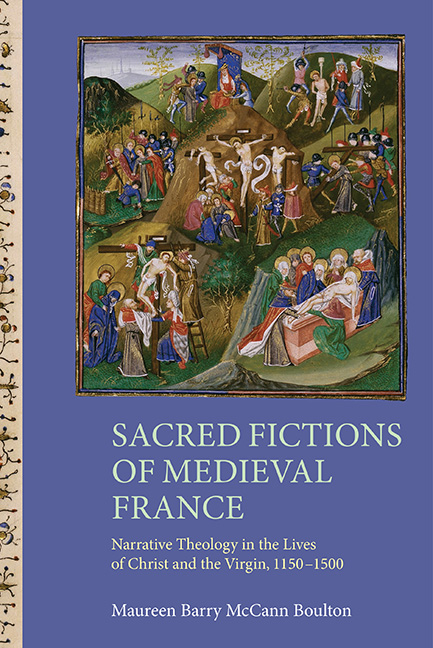 Sacred Fictions of Medieval France
Sacred Fictions of Medieval France Book contents
- Frontmatter
- Dedication
- Contents
- Acknowledgements
- Abbreviations
- Introduction
- 1 Sacred Romances: Genealogy, Lineage and Cyclicity
- 2 Sacred Epic and the Diffusion of Anti-Jewish Sentiment
- 3 Sacred Allegory and Meditation
- 4 Sacred Histories: the Chronicles of Jean d’Outremeuse and Jean Mansel
- 5 Sacred Imaginations: Lives of Christ and the Virgin in Texts of A ffective Devotion
- Epilogue: Lives and Afterlives
- Appendix: Lists of Manuscripts by Chapter
- Bibliography
- Index
1 - Sacred Romances: Genealogy, Lineage and Cyclicity
Published online by Cambridge University Press: 11 June 2021
- Frontmatter
- Dedication
- Contents
- Acknowledgements
- Abbreviations
- Introduction
- 1 Sacred Romances: Genealogy, Lineage and Cyclicity
- 2 Sacred Epic and the Diffusion of Anti-Jewish Sentiment
- 3 Sacred Allegory and Meditation
- 4 Sacred Histories: the Chronicles of Jean d’Outremeuse and Jean Mansel
- 5 Sacred Imaginations: Lives of Christ and the Virgin in Texts of A ffective Devotion
- Epilogue: Lives and Afterlives
- Appendix: Lists of Manuscripts by Chapter
- Bibliography
- Index
Summary
Grans joies fu quant Dix fu nes
Et grans dolours quant fu penés,
Mais il le soufri bonement
Pour racater toute sa gent,
Et par une virgene pucele
Qui tant par fu courtoise et belle.
(Turin, Bibl. Naz., L.II.14, fol. 24rb)[There was great joy when God was born and great sorrow when he suffered, but he suffered it gladly to redeem all his people, and through a virgin maiden, who was most courteous and beautiful.]
Before it came to designate a literary genre, the old French word roman indicated the (vernacular) language of a text. A work in roman was set off from Latin, the learned and liturgical language, and aimed at a lay rather than a clerical audience. The ‘translation’ of Classical learning from Latin to romance was a major element of the mise en roman, at least implicitly, but often explicitly. The genre designated roman emerged in the course of the twelfth century with numerous distinctive, if not exclusive, characteristics. The first of these was its formal structure, the octosyllabic couplet (also used for chronicles and saints’ lives). Its mode of delivery, by means of a written text read aloud to small groups, distinguished it from the chanson de geste, often sung or declaimed to a larger public. Most romancers legitimized their enterprise by citing (or inventing) older, often Latin sources. Having eschewed originality of subject matter, they located the value of their offering in the manner of its telling. One of the defining characteristics of romance, especially from Chrétien de Troyes, but to some extent before him as well, was the art of ‘conjoining’ diverse elements into a new and artful whole. Equally important to the manner of telling the story were rhetorical devices, particularly those related to amplification, including description and dialogue. The subject matter of romances is often preoccupied with questions of genealogy and lineage. Certainly Chrétien de Troyes in the Conte du Graal showed his hero gradually discovering both the weight of his family heritage and his network of familial connections. Preoccupations with heritage recur in the Vulgate Cycle with the insistence on the lineage of Lancelot and Galahad in both the Prose Lancelot and the Queste del saint graal. In England, the family theme was important enough to inspire a series of literary works collectively described as ‘ancestral romances’.
- Type
- Chapter
- Information
- Sacred Fictions of Medieval FranceNarrative Theology in the Lives of Christ and the Virgin, 1150–1500, pp. 21 - 80Publisher: Boydell & BrewerPrint publication year: 2015


